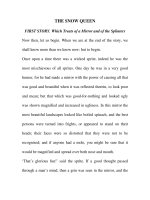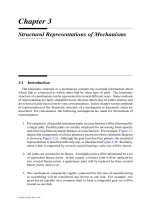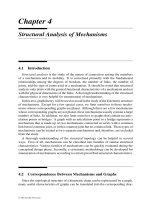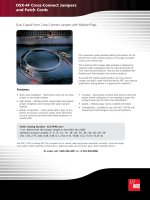Tài liệu Discussion of Firm Efficiency Level and Equity Returns ppt
Bạn đang xem bản rút gọn của tài liệu. Xem và tải ngay bản đầy đủ của tài liệu tại đây (92.11 KB, 2 trang )
Discussion of Firm Efficiency Level and
Equity Returns
The term "efficient" firm is widely used in economics. For example, an efficient firm is
the one producing at Marginal Cost = Marginal Revenue. However, in finance, an
"efficient" firm has no specific meaning. We hear efficient market but not efficient
firm. Primarily because of two reasons. First, efficiency or MC=MR is difficult to
estimate in finance. Second, so what if the firm is efficient? Why should an investor
care? Economic theory never told us anything about what will happen next. Maybe a
firm is efficient right now will not be in the future. Or if the firm is efficient does that
mean its next year stock return will be higher? So why care?
A forthcoming article by Nguyen and Swanson (2007) in the Journal of Financial
and Quantitative Analysis addresses both of the concerns. Here's its summary
snapshot.
The paper is divided into two main parts.
In the first part, Nguyen and Swanson propose the application of Stochastic Frontier
Analysis (SFA), a parametric approach used in productivity economics, to estimate
firm efficiency level. While SFA is widely used in economics (also in some economic
literature dealing with Vietnam), there have been only 2 SFA papers in top tier finance
journals. Essentially what SFA does is estimating a hypothetical value a firm could
have obtained if it were to maximize firm value. The deviation from the maximum
value is defined as "inefficiency level". Hence, firms with low "inefficiency" are
classified as the "efficient" firms.
Once firm efficiency levels are determined, Nguyen and Swanson proceed to examine
firm performance using asset pricing techniques. Specifically, the authors create deciles
(or portfolios) of firms based on the efficiency level. They further create a hedge
portfolio which takes a long position in the most inefficient firms and a short position
in the most efficient firms. Nguyen and Swanson track the performance of hedge
portfolio after adjusting for Fama-French and Carhart (1997) 4-factor model along with
Daniel and Titman (1997) characteristics-based benchmark.
The paper provides the following main conclusions:
1. A trading strategy of longing inefficient firms and shorting efficient firms yields, on
average, a 0.76% monthly risk-adjusted profit. That is almost 12% annual profit.
2. A 5-year buy-and-hold strategy of the hedge portfolio generates, on average, a 44%
cummulative return over the course of 5 years.
3. Nguyen and Swanson argue that the difference in performance is generated by a
premium associated with investing in highly inefficient firms (much like Fama and
French's value premium argument).
4. Interestingly, the authors document that over time the efficiency level of the most
inefficient firms tend to increase. This coincides with Fama and French (1995)
argument that the worst firms are forced to improve in order to survive in the market.
5. Nguyen and Swanson further document that firm efficiency level appears to subsume
the information that is present in Book-to-market ratio (Fama and French's main ratio).
The paper provides the following implications and opportunity for further expansion:
With respect to Asset Pricing Models:
1. Since current asset pricing models (CAPM, 4-factor and 5-factor by Pastor and
Stambaugh) fail to explain the inefficiency premium, should inefficiency premium be
included as a pricing factor?
2. Is inefficiency a risk-factor? In other words, is it an aggregate annomaly? Or is it
simply a firm specific characteristics phenomenon (as in Daniel and Titman argument)?
With respect to Corporate Finance:
Nguyen and Swanson document improvement in efficiency among the most inefficient
firms. What caused the improvements? Actions by the board of directors (e.g. firing the
manager)? Increase in compensation? Cost reduction? Or something else?
With respect to International Finance and Vietnam:
Does inefficiency premium exist in other markets?
With respect to Portfolio Management and Security Analysis:
Since inefficiency appear to subsume the information that is present in Book-to-market,
then should portfolio managers consider incorporating inefficiency into Style
Investments? For example, instead of high B/M being value firms we might have high
inefficiency? Note that B/M is a much better proxy for value/growth effect than P/E ratio
(Fama and French).









